The Strokestown Park House Archive
Published in 18th–19th - Century History, Features, Issue 4 (Winter 1995), The Famine, Volume 3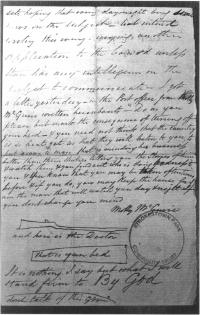
Fig.1. A threatening letter signed by ‘Molly Maguire’. Note the ominous sketches of a rifle and coffin.
Strokestown Park House, one of Ireland’s finest Palladian mansions, and the last in County Roscommon to remain intact, has been the focus of much public attention as the site of Ireland’s first Famine Museum, which occupies its adjoining stable wing. The museum was opened by President Robinson in May 1994 (see HI Summer 1994), and now enjoys an international profile, linking the past experience of the Great Irish Famine on the Strokestown estate, with the ongoing spectacle of poverty and hunger in today’s developing world. The development of the Famine Museum at Strokestown Park is one aspect of restoration work being carried out by the Westward Group, a local business consortium, who purchased the property from the Pakenham Mahon family in 1979, subsequently opening the house and gardens to the public. It is now regarded as the finest privately funded restoration project in Ireland.
The Strokestown estate
Strokestown House with its adjoining demesne and associated estate town, formed the core of the landed estate of the Mahon (later Pakenham Mahon) family for over 300 years. By the early eighteenth century, the estate comprised over 11,000 acres, scattered throughout north east Roscommon, put together from the later seventeenth century as a result of land acquisitions by Captain Nicholas Mahon, c. 1660. Later, his great-grandson, Maurice Mahon, purchased several additional lands, following elevation to the Irish peerage as the first Lord Hartland in 1800. The family continued its association with Strokestown until 1981, when, eight generations later, Mrs Olive Hales Pakenham Mahon moved to a nursing home in England, at the age of eighty-seven.
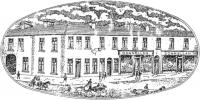
Fig.2. The receipts and bills category contains thousands of individual receipts for all kind of goods. This one beautifully embellished by engraving of a corner shop in the main Strokestwon.
Estate and family papers
The Pakenham Mahon family’s prolonged association with Strokestown has resulted in the creation of a large collection of estate and family papers, located both in Strokestown Park and the National Library of Ireland (NLI) in Dublin. These papers represent a unique feature of the Irish Famine Museum and Strokestown. A wide range of documents forms the basis of the exhibition. Key archives are regularly updated, chronicling the multi-faceted aspects of estate life over a long period. Documents which have recently come to light include a threatening letter signed by none other than ‘Molly Maguire’. Note the ominous sketches of a rifle and coffin (see fig.1).
The Pakenham Mahon papers contain information extending from the seventeenth century until 1981. As well as providing valuable information on the effects of the Famine on the estate, they also reveal important background information on the factors which shaped local society in County Roscommon. The entire collection, comprising the Pakenham Mahon papers, together with the more recent restoration-related documentation, is now referred to as the ‘Strokestown Park House Archive’.
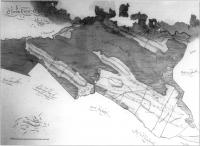
Fig.3. Map of the Sandsford family’s Castlerea estate drawn by the estate surveyor John Longfield in 1819.
Provenance of the Pakenham Mahon papers
The peculiar division of the Pakenham Mahon papers between Dublin and Strokestown resulted from a survey of records in private hands, carried out by Sir John Ainsworth for the National Library during the late 1940s and early ‘50s. He surveyed the papers in situ, describing them as a valuable collection, being the property of Mrs Olive Hales Pakenham Mahon, and persuaded her to transfer the bulk of the papers to the library for permanent safekeeping. However, whilst agreeing to deposit a substantial amount of material in the library, Mrs Pakenham Mahon decided to retain papers dating from the Famine period onwards in Strokestown (c. 1845), for some reason which remains undocumented. Approximately 5,000 documents are located in the National Library, while an additional 18,000 documents remain in situ at Strokestown House.
Material in the National Library covers the period from c. 1660, when the Mahon association with Strokestown began, until c.1845, when Major Denis Mahon inherited the estate. There is also a smattering of leases, maps, surveys, correspondence and Land Commission papers, covering the period 1850-c.1909. Following acquisition by the Library, most of this material was roughly sorted and assembled into folders, to which manuscript numbers were allocated. In addition to sorted material, a further 115 bundles of deeds, leases, and other legal papers remain unsorted in Library storage.
Correspondence in the National Library is particularly rich, covering the period from the 1730s to the 1850s in some detail. Library staff have grouped letters to or from a particular individual in chronological order (a useful arrangement for research purposes), but it is a pity that more detailed information is not available. Only a broad outline is provided by the Hayes Manuscript Sources for the History of Irish Civilisation and its various supplements—the only means of direct access for the public. The absence of a detailed sectional list limits access as far as the cursory user is concerned.
When the Westward Group purchased Strokestown Park in 1979, the estate and family papers remaining in Strokestown were included in the sale, with the result that the Strokestown collection remains in the place of its original provenance. Here it is complemented by the wide variety of original artefacts which also remain, including books, family portraits, and other paintings. The books in particular form a valuable local history resource in their own right, including first editions of Weld’s Statistical Survey of County Roscommon, Young’s Tour in Ireland, and editions of local newspapers. Hundreds of other books indicate wide-ranging family interests including gardening, travel, dog breeding, early photography and exotic art.
The dual location of the Pakenham Mahon papers hinders research for users of the collection, as there is no clear cut-off date for the papers in either place. Unfortunately, it is not possible to marry both parts of the archive in Dublin and Strokestown together in a physical sense, on account of Mrs Pakenham Mahon’s desire that material in the National Library remain there permanently. However, recently an agreement has been worked out by the trustees of the Library with the Westward Group, which aims to improve access to the archive collection as a whole. This will involve a complete re-sorting and ordering of the papers, followed by the entry of detailed descriptions about each item in a computer database.
The database solution
Sorting work has already begun in Strokestown, and a tailor-made computer database (designed by Softworks Computing Ltd., Bray, County Dublin) is being developed to meet the specific requirements of the entire archive. The database will provide a sophisticated finding aid, catering for documents in Strokestown and the National Library, thus maximising their potential for all types of users.
Having been filed manually, and assigned a unique reference number, a description of each individual document (or bundle of documents relating to a specific subject), will be entered into a corresponding database record. Each record will consist of eight fields. The first field will provide a broad description of the record concerned, followed by a breakdown of specific details in the other seven fields. In the next field for dates, covering or specific dates will be entered by day, month and year, facilitating the requirements of users with broad date and/or specific date searches. Next the unique reference number of each record will be entered. Material located in the National Library will be prefixed by the code ‘NLI’, while the code ‘SPH’ will prefix material located in Strokestown, thereby distinguishing items from each place, and overcoming the problems associated with the overlapping of records from two different locations. All subjects and names mentioned in a particular archive item will be entered in the next field, after which all place names, including countries, counties, towns, streets, townlands and parishes, will be entered. The last three fields will be used for administrative purposes, catering for details such as the number of items in a single record file, the condition of the documents (whether in need of conservation, any seals or stamps attached, etc.) and any writing annotated or imposed on the document in a different hand to that of its original author.
The database system will be an interactive one, permitting staff and other users alike to interrogate the system for their own specific needs. Searches may be confined to a specific field or broadened to cover any combination of fields. The database can be asked to list all leases in the archive in chronological order. More specifically, all leases relating to the town of Strokestown may be asked for, or more specifically again, all leases relating to the town of Strokestown involving Major Denis Mahon as a party, and covering a specific period of time (either days, months, or years) may be isolated by the system. Searchers will be able to work through records of relevance to their search, either by scrolling down the records listed on the screen, and/or from a printout of the listed records. Ultimately, sequential lists of individual records in specific archive categories will be made available by the system, both on disc and in hard copy.
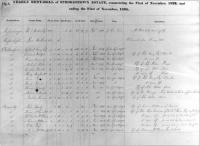 The collection in Strokestown Park House
The collection in Strokestown Park House
After the assassination of Major Denis Mahon in November 1847, at the height of the Famine crisis on the Strokestown estate, his only daughter, Grace Catherine, vowed never to return to her ancestral seat. She was on honeymoon at the time, having been married only weeks earlier, to Henry Sandford Pakenham, son of Dean Henry Pakenham of Tullynally, and heir to the vast Pakenham and Sandford estates in counties Longford, Westmeath and Roscommon. True to her promise, Grace Catherine never returned to Strokestown, but her fortuitous marriage undoubtedly saved the estate from bankruptcy. On the eve of the Famine, the estate was in debt to the tune of over £30,000, accrued as a result of family settlements and expensive land purchases which had gathered from the second half of the eighteenth century.
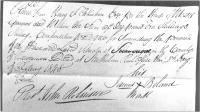
Fig.5. An ‘x’ above the tenant’s name – a lasting testimony to illiteracy – on a receipt to one James Boland for the surrender of his land in return for passage memory to the United States.
The marriage alliance (by which Henry Sandford Pakenham assumed the additional surname of Mahon), united the estates of both families to comprise over 26,000 acres, and the Strokestown estate remained one of the largest in Roscommon until his death in 1893. The Pakenham fortune also enabled large scale investment in various estate improvement projects on the Strokestown estate, including drainage, turf cutting and agricultural schemes, development of the urban market in the town of Strokestown, and assisted emigration of tenant families to the United States.
The prolonged association between the landowning family and the Strokestown locality has created a vast quantity of documentation, mostly dating from the mid-nineteenth century, until Olive’s final departure in 1981. Over the past year these documents have been completely reorganised. All of the material has been moved from the study and adjoining dark room in Strokestown House, where it was initially stored, to an office in the museum.
The accounts category contains general statements of estate and family income and expenditure, including household account books, estate balance sheets, income tax books and family banking records. In contrast, the receipts and bills category contains thousands of individual receipts for all kinds of goods, from garden seeds and farm machinery, to household furniture, food and drink. Some of the bills are beautifully embellished with line drawings, such as the engraving of the corner shop in the main street of Strokestown (see fig.2).
The maps at Strokestown include a fine collection of coloured maps of the Sandford family’s Castlerea estate, drawn by the estate surveyor John Longfield in 1819 (see fig.3). These came to Strokestown after the Pakenham-Mahon marriage alliance of 1847. There are also over sixty family photographs from the dark room, some of them developed by another family member, during the early l900s.
The Strokestown collection also includes two early nineteenth-century rentals (see fig.4), in addition to a further run of rent books for the early 1850s, and another run for the period after 1917. These sources permit comparative analysis of estate rent income at various stages of its history. There are also several surveys of property, livestock and people on the estate, including an estate census compiled by the estate office in 1847, which accounts for the names and numbers of families occupying individual holdings, the size of each holding and its location on a townland basis.
Leases, family settlements and tenants’ agreements include some odd leases dating from the 1740s onwards. Many of the leases are duplicated by the very extensive collection in the National Library, but there are also over 400 original agreements made with weekly and monthly tenants in the early l900s.
The largest component of the archive at Strokestown is the correspondence, spanning the period 1835-c.1900. Approximately 7,000 letters have been organised into sub-groups. Specific sub-groups have been assigned to the letters of individual estate employees, which has helped to reconstruct accurately the structure of estate management over a long period. For example, all of the Guinness Mahon and Co. correspondence (relating to this company’s estate agency business which operated from premises in the town of Strokestown between 1847 and 1914), is grouped together in chronological order, forming a significant component of the collection in its own right.
The labour returns—the next archive group—not only reflect the business acumen of the estate agency business, but also provide a rare insight into rural employment patterns and wage rates on a typical nineteenth-century Irish estate. These returns were compiled on a weekly basis, listing the numbers of workmen and horses employed on various parts of the estate, the jobs they carried out, the hours they worked, and the wages they were paid.
Miscellaneous documentation at Strokestown includes press-cuttings, (many of family or local interest); nine volumes of poor-rate receipts for the Strokestown Board of Guardians, (established in 1851); military documents; lists of people to whom food was distributed prior to the famine crisis of the 1830s and early ‘40s; and eviction notices served on tenants in arrears.
A special archive category has been assigned to emigration-related material on account of the post-Famine emigration schemes sponsored by the Pakenham Mahons. This includes hundreds of receipts which were issued by the estate office to individual tenants when the latter surrendered their land, in return for passage money to the United States. With few exceptions, most of the receipts carry the mark (as opposed to the signature), of the tenant concerned. The mark (an ‘x’ in the shape of the crucifix), was made just above the tenant’s name—a lasting testament to local illiteracy (see fig.5).
So far twentieth-century material at Strokestown, comprising about 10,000 documents, has only been roughly sorted. Items of note from this period include a run of love letters between Olive Pakenham Mahon and her future husband, Major Stuart Hales. He was an officer in the Ninth Lancers, and the couple met when he was garrisoned at Strokestown House, during the Irish War of Independence. They were married in London in 1922. Two boxes of Land Commission schedules relating to parts of the estate which were sold to the Irish Land Commission from 1905, and one box of papers concerning the Arigna Mining Company (in which the family appear to have held shares), complete the collection.
Future plans for the archive
The Strokestown Park House Archive project is an ambitious attempt to provide an extensive finding aid to this important collection of papers. Although still at an early stage, plans are firmly laid to develop the archive as a local history resource, and make its contents widely available. As part of ongoing restoration work at Strokestown, a former tack room above the vaulted stables will be converted into an environmentally-controlled archive repository for storage of papers, while the adjoining room (once a gymnasium) will be restored and converted into a public reading room and display area.
The archive project also compliments educational developments already underway at Strokestown House and the Famine Museum, where there is an active policy to promote history teaching outside the classroom. The Famine Museum employs a full-time education officer, which is of special relevance in the context of recent curriculum changes in the South at both junior and senior levels, placing greater emphasis on local history and use of documentary sources. For third level students, the archive presents innumerable sources for research. One doctoral thesis on the development of the town of Strokestown has already been completed, while the MA in Colonial Studies at University College Galway incorporates fieldwork at Strokestown and the use of source material into course work.
The Strokestown Park House Archive represents a part of the complex legacy we have all inherited from the past, for the benefit of future generations. Enquiries about access to the material in Strokestown, and the database finding aid, may be addressed to Susan Hood, The SPHA project, Strokestown Park, County Roscommon.
Susan Hood is Research Officer at the School of Environmental Studies, University of Ulster.
Further reading:
S.J. Campbell, The Great Irish Famine. Words and images from the Famine Museum, Strokestown Park, County Roscommon. (Strokestown 1994).
R. Scally, The end of hidden Ireland. (Oxford 1995).
S. Hood, ‘Through the gates—power and profit in Strokestown, County Roscommon’, in Finn-Einar Elissen and Geir Atle Ersland (eds.), Power, profit and urban land. (Leicester, forthcoming).
Jim Fahy, ‘Interview with Olive Hales Pakenham Mahon’, on Looking West, taped production (RTE 1981).
















